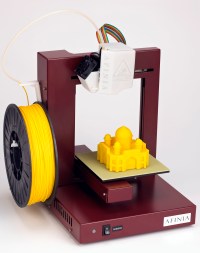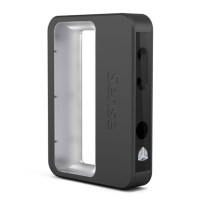If we’ve crossed paths in the past week, there’s a pretty good chance I’ve scanned you. This extends well beyond the human race, into the realms of animal, vegetable, plush toy and fruit bowl. Some subjects were too small to be scanned, some too fidgety and, in the case of my attempted 3D selfie, not nearly flexible enough. Such issues were mere roadblocks in my strange one-man journey to 3D-scan the world. I may have a problem. I admit it. For starters, I’m not completely sure what I plan on doing with all these scans, but while such questions are entirely logical, they’ve yet to curb my enthusiasm for the device. Sense is one of those propositions that seems too good to be true: a user-friendly, (relatively) portable 3D scanner capable of capturing objects up to 10 feet by 10 feet, and at a fraction of the price of the competition.
If the product is indeed what 3D Systems claims, it could fill a major hole in the consumer 3D-printing market. In recent years, 3D-printing companies have largely focused on the printers themselves, which have gotten cheaper and easier to use. At the same time, the race to dominate the category has often caused companies to ignore the question of how those without extensive CAD experience can create 3D files in the first place. MakerBot unveiled its solution back at SXSW: the $1,400 Digitizer, a rotating, desktop scanning bed capable of capturing objects up to eight inches by eight inches. 3D Systems’ Sense takes a wholly different approach: This is a $400 handheld scanner that can digitize an entire human being.%Gallery-slideshow123207%
Filed under: Peripherals
Dave Nunez loves to make tiny 3D printed models of video game consoles and computers. His latest mini gaming machine is based on none other than Microsoft’s latest and hugest, the Xbox One. It’s so tiny I don’t think a penny can fit into its disc slot – though a dime might.
As you can see Dave also made a tiny Kinect. Fortunately Dave’s not requiring you to print both – and there’s no massive power brick either. Perhaps Microsoft will consider both of these revisions.
Xbox, head to Thingiverse. Xbox, download the 3D files for free. Xbox, browse Dave’s Thingiverse page for more mini gaming machines.

Your iPhone could be getting some serious new capabilities soon, following the news that Apple has acquired the 3D-sensing technology company PrimeSense. This is the same Israeli company that built the original Microsoft Kinect sensor. But that doesn’t mean Apple’s planning an Xbox competitor anytime soon.
![]()
If there was any doubt that Motorola would continue to push forward with their modular smartphone project through the future, it’s been given another kick in the pants today. Motorola Mobility LLC, A Google Company, has today announced their new partnership with the 3D printing group 3D Systems for the modular smartphone system called Project […]
Sam Cervantes didn’t stand on his new printer when he brought it by our offices the other day. He thought about it for second, a nice reprise of the day he introduced us to its predecessor late last year, but, well, he’d only just pulled that first unit out of the box for the first time, and he didn’t want to scuff up its finish or dent the new enclosure. As to whether the new 3D printer could sustain the weight of a full grown man, he certainly thinks so. It’s still got that steel structure, after all. Maybe we can convince him to put on a show at CES in January.
Structural integrity questions aside, the latest printer from Solidoodle is a nice looking thing, certainly. As the Brooklyn-based company began looking to expand its sales footprint beyond enthusiast-based direct marketing, it no doubt realized that it would have to produce a product that could live on store shelves comfortably next to, say, a laptop or an HP printer. It sounds silly, sure, but big box stores aren’t particularly interested in stocking products that look as though they might have been built in someone’s garage. For all its charms, the Solidoodle 3 had a certain home-brewed quality to it. The new printer goes firmly in the other direction, with a metal enclosure that wouldn’t look too out of place in a lot of homes.%Gallery-slideshow122778%
Filed under: Peripherals
3D printing is all the rage and it’s hard to know just where to start. If you have a budding manufacturing magnate on your Christmas list we’ve got a few fun things for them to check out. One word of advice? Don’t buy cheap 3D printers. I’ve tested a few so far and a number of the “cheap” open source models and some of the models you find at Office Depot are unusable at best. It hurts me to say this but there is really a race to the bottom when it comes to 3D printing right now. Things may be expensive, but like any early-adopter you should save your pennies and pick the right model for the job.

 First, I’d recommend the Makerbot Replicator 2X, an “experimental” Makerbot that can print using corn-starch-based PLA and plastic ABS.
First, I’d recommend the Makerbot Replicator 2X, an “experimental” Makerbot that can print using corn-starch-based PLA and plastic ABS.  Being able to print in both materials is vitally important if you want to make high quality items and each material has its different qualities. For example, you can print translucent objects with PLA but not ABS and ABS objects are far more resilient than PLA objects.
Being able to print in both materials is vitally important if you want to make high quality items and each material has its different qualities. For example, you can print translucent objects with PLA but not ABS and ABS objects are far more resilient than PLA objects.
At $2,799 it’s not a cheap toy, but if you’ve been planning to jump into 3D printing there’s no time like the present. I actually make a little money using MakeXYZ, a market for 3D printed objects. By printing things for other people you can actually pay for the ‘bot and the printing material in a few months.
Want to spend a little less? Take a look at the Afinia H series, a $1,599 printer with a smaller build plate than the Makerbot but, in some ways, superior resolution. I tested the rugged little Afinia and came away impressed. You can order the printers here.

 One of my favorite products of 2013 was the Makerbot Digitizer. It’s a $1,400 3D scanner that can scan in almost any object. I reviewed it here calling it close to magic, which is the truth.
One of my favorite products of 2013 was the Makerbot Digitizer. It’s a $1,400 3D scanner that can scan in almost any object. I reviewed it here calling it close to magic, which is the truth.
Don’t want to spend too much? 3D Systems has released the Sense scanner, a $399 model that requires you to move the scanner around an object in 3D space. They’re beginning to ship now and we’ll have a full review shortly, but that’s the gist of it.

Finally, you could probably use some filament. While Makerbot sells their own excellent filament, I’ve had good luck with Monoprice. You may have to mess around with the spool holder for your printer – Monoprice’s spools don’t fit the stock Makerbot spool holder – but you will save about $25 off of Makerbot’s prices.
Be sure to leave plenty of room under the tree for your printers – these things aren’t tiny – and enjoy entering the amazing 21st century.
3D printing is used by scientists in many fields of study for things such as rapid prototyping and more. A group of German researchers recently used a 3D printer along with CT scanning to print a version of a fossil without having to remove the delicate fossil from its protective plaster covering. The new technology […]
MakerBot MakerWare 2.4 software gets MultiScan technology for desktop scanner
Posted in: Today's ChiliMakerBot has announced the launch of a new version of its MakerWare software for its desktop 3D scanner. The MakerBot Digitizer Desktop 3D scanner was first announced back in March of this year and the desktop 3D scanner began shipping in October. MakerBot has announced that version 2.4 of the software for the scanner is […]
Toward the end of the C Enterprise’s Kickstarter pitch, one employee explains the genesis of the product’s name, “it’s a robot in a box.” And thus the name Robox was born. The product’s probably more accurately described as a 3D printer trapped in what appears to be a toaster oven — though there are some caveats to that, too. See, the company’s jammed a lot of things into the device’s printer head, while also making the piece removable. That means there’s some interesting potential for future attachments that could make it possible to scan or mill with the thing. In the meantime, however, printing is the product’s primary focus, and the head features two nozzles: a thin one for the perimeter and a thick one for filling objects — a process it promises will speed things up considerably.
There’s also an auto-shutoff for the extruder, so you don’t get any dangling plastic pieces when the print is finished. At launch, Robox will support PLA and ABS, though the company’s also offering up a long list of potential compatible materials, including nylon, polycarbonate and PVA. Robox is set to retail for around $1,400, though early supporters will be able to snag one for $1,130.
Filed under: Peripherals
Source: Kickstarter












